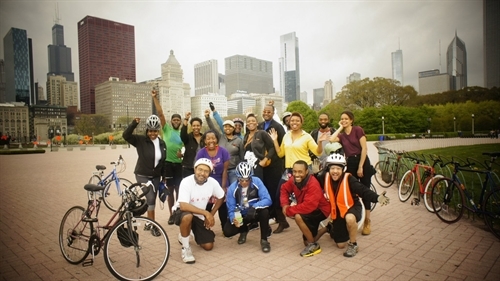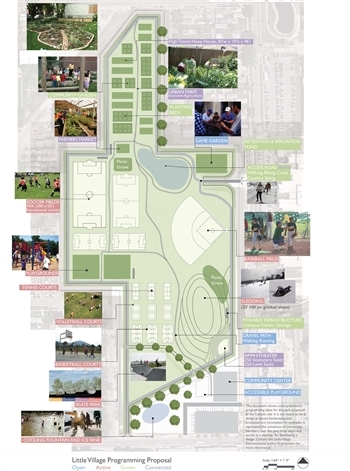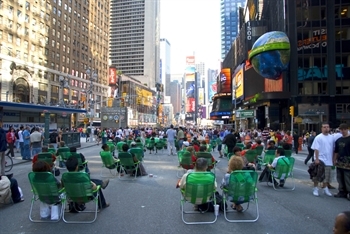
Ethan Kent, Project for Public Spaces
Throughout January, MPC’s blog, The Connector, is running a series on the tangible benefits of Placemaking. Read the other entries:
Sometimes it’s hard to define what makes a great place, but you know it when you experience it. Great places lure people in with activities, people watching, shopping or just the experience of being around others and feeling a sense of connection. Does this only happen at organic farmers markets or outdoor cafes? Hardly. Placemaking doesn’t just occur in affluent communities or vacation hotspots. Chicago’s 26th street in Little Village, 18th Street in Pilsen, or the Glenwood Market in Rogers Park are evidence that the power of a vibrant public place transcends geographic and demographic boundaries.
Peter Kageyama, author of For the Love of Cities, writes that creating places worth caring about makes for strong communities. We couldn’t agree more. That’s why we have designed a blog series that considers the importance of placemaking for communities through a variety of lenses. The series will explore the economic, environmental, physical and social aspects that produce quantifiable benefits for a community and its residents.
Last week’s post started out being about the health benefits of great places. And it still is, but I found that, rather than trumpeting how much less likely you will be to have diabetes if you bike to work every day, I had a lot more to say about how hard it is to actually achieve those benefits in this country. So I covered how the built environment plays a major role in the activity levels of community residents - how a lack of sidewalks leads high schoolers to bum rides to school rather than walk, how sprawl has made it increasingly harder to walk to achieve any of our day to day needs, and how low-income communities have many fewer options for walking and recreation. It was pretty depressing, come to think of it. So today, on a hopeful note, I will highlight how a few small groups of people are making inroads against the odds to make their communities healthier.
In Bronzeville on Chicago’s mid-South Side, the Bronzeville Biking Collaborative was formed in 2012 because neighborhood leaders knew that biking assets were being planned by city leaders, but few Bronzeville residents were prepared to take advantage of these new investments. Although the City of Chicago overall is dramatically increasing bike lanes (including one on Bronzeville’s King Drive) and implementing a Bike Share program covering 26 wards beginning in Spring 2013, neighborhood leaders recognized that the area lacks the bicycling culture to take full advantage of these opportunities. Recruiting biking enthusiasts from around the city – including Eboni Hawkins of Red, Bike and Green, an African-American biking advocacy group, and Cynthia Bell, a native West Sider who now works through the Active Transportation Alliance to build cycling in underserved areas – they have set out to identify the skills, culture, and infrastructure requirements for growing biking, and improving health, among Bronzeville residents. One of the group’s organizers, Bernard Loyd, notes that "Increasing the use of bicycles not only improves health and wellness but also creates job opportunities in bicycle repair and maintenance and encourages bicycle tourism, all important opportunities for Bronzeville."

Red Bike & Green on a recent ride around Chicago
Daris Jasper
Everything from the $75 yearly bike share membership fee to the need for a credit card to access it to a paucity of bicycle and bicycle repair shops throughout the South Side present real barriers to the local bike scene reflecting Chicago’s diversity. GRID Chicago’s (now Streetsblog Chicago’s) recent article, “Bike share, not white share: can Chicago’s program achieve diversity?,” notes that the City’s Dept. of Transportation (CDOT) is trying to address these barriers through innovative partnerships with community organizations and churches, which could provide bike share access for people who don’t have credit cards. CDOT is also working to spread a culture of biking – and bike-related jobs - by running a pre-launch internship program in which young people from bike-education centers like Humboldt Park’s West Town Bikes and Blackstone Bicycle Works in Woodlawn will learn how to assemble the bike share kiosks and maintain the bikes. We will definitely keep up with the efforts of the Bronzeville Bike Collaborative and CDOT as they push for more diverse bike share usage across Chicago.

Richard Pack
On Chicago’s Soutwest Side in Little Village (technically the community area of South Lawndale), we again see a disconnect with the assumption that density equals walkability, which equals healthy. While Little Village is very dense (15,000 people per square mile, compared to 10,000 in neighboring North Lawndale) and has countless retail destinations, particularly along the thriving 26th Street corridor, this still has not translated into improved health outcomes for the neighborhood’s residents. In fact, the area has long shown notably poor health outcomes due in part to a large number of toxic factories, but also to the basics of lacking green space. What kind of poor health outcomes? In 1999 – 2000, the Sinai Urban Health Institute found that the diabetes mortality rate was 40 (per 100,000 population), compared to 31 in Chicago and 25 nationwide. A later survey measuring moderate physical activity in six community areas found that respondents from South Lawndale were least active (15 percent), compared to 47 percent nationally. 42 percent of individuals were completely inactive, reporting no significant physical activity at all.

Percent of Adults Who Are Active
Sinai Urban Health Initiative, Improving Community Health Survey, Report 2, September 2005
As noted in part I of this post, this neighborhood has the least green space per capita of any of the city’s community areas. Local leaders have set out to change that. The Little Village Environmental Justice Organization (LVEJO), which campaigns against pollution and for clean power, park facilities, urban agriculture, and restoring public transit, worked with neighborhood leaders to identify a former asphalt factory site as an ideal location for a park. After a decade-long fight to transform the 24-acre former Celotex asphalt factory site, last year the City and the Chicago Park District announced that they will invest $8 million to develop the space into a new park. Rather than a space that contributes to the area’s high air pollution, as of 2014 it will be quite the opposite: several soccer fields with field lighting, a soft-surface playground, baseball fields, basketball courts, a skate park, and walking and jogging trails. Kudos to Little Village community leaders for pushing for - and winning - a safe place to be active in their community.

LVEJO's park site plan (click for full size)

Lawn chairs in Times Square
Katy Silberger via Flickr
So creating places where walking is safe and practical, biking is part of the culture, and parks provide sufficient play space for its residents can be hard. On the upside, once advancements are made, the gains in health outcomes can be quite dramatic: In an earlier post in this series, I noted how New York City officials had transformed Times Square into a pedestrian plaza and reaped major economic benefits because of it. It turns out that re-engineering this space for pedestrians has yielded significant health benefits as well; back in 2009, when Times Square was still a chaotic mess of bumper-to-bumper traffic, a study of air quality in the plaza found that concentrations of nitrogen oxide and nitrogen dioxide, two pollutants closely associated with traffic, were among the highest in the city. After the conversion to a pedestrian plaza, nitrogen oxide pollution levels in Times Square went down by 63 percent, while nitrogen dioxide levels decreased by 41 percent.
The creation of healthy, walkable communities is not only a quality of life matter, but a matter of life and death. As noted in part I of this post, incidence of chronic diseases like obesity, diabetes, and heart disease is through the roof, and is only worsened by communities in which people are car-dependent, lacking green space, and fear for their safety if they walk. I've highlighted examples of community leaders in Bronzeville and Little Village who are pushing to change residents' access to and comfort level with being physically active, but policy makers, planners and city leaders also have a responsibility to prioritize the creation and maintenance of healthy communities.We can't have great places without it.